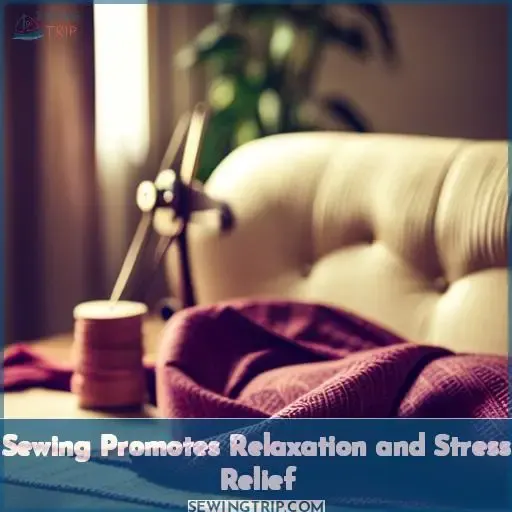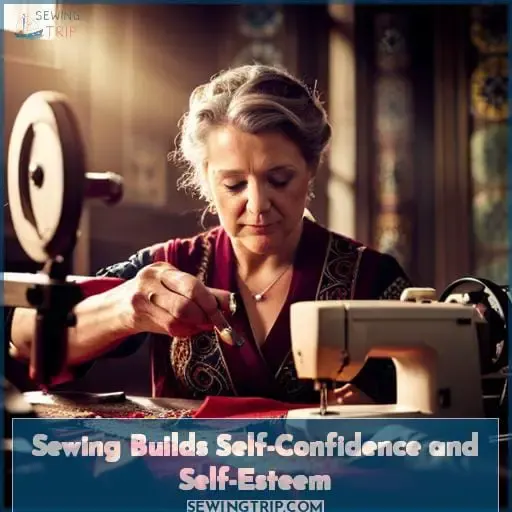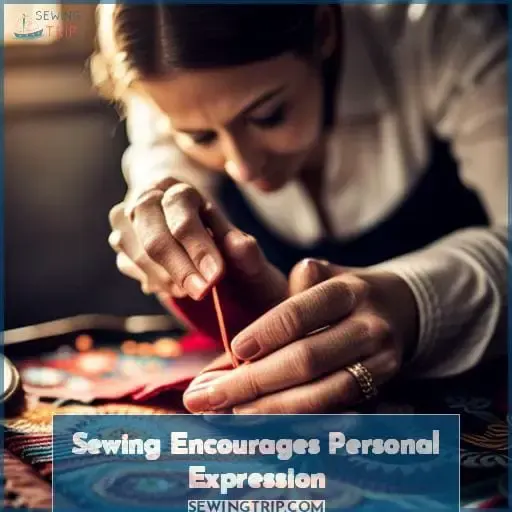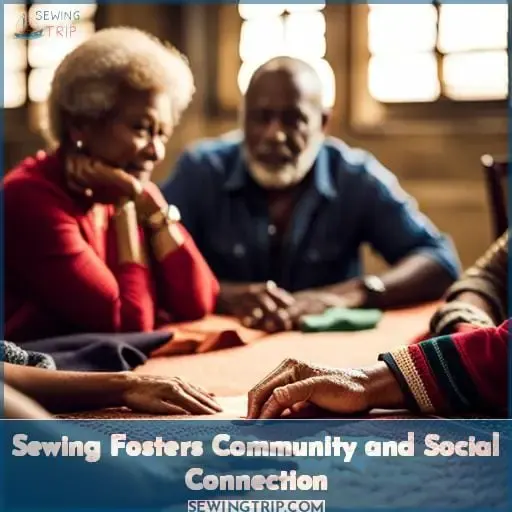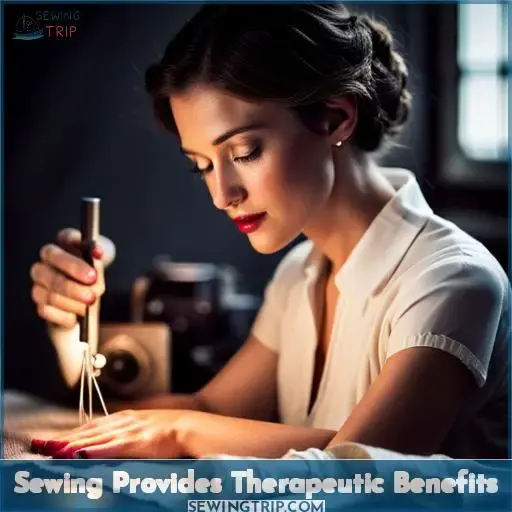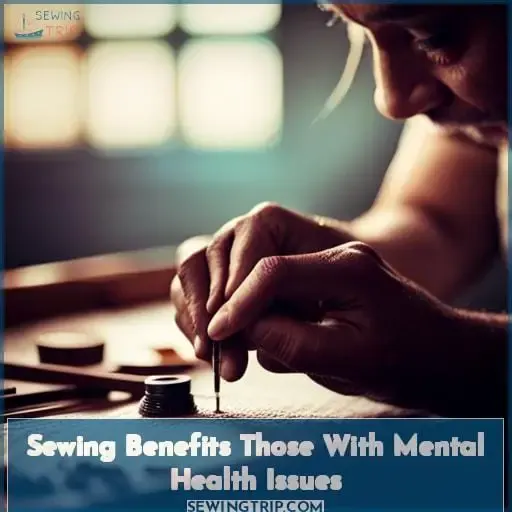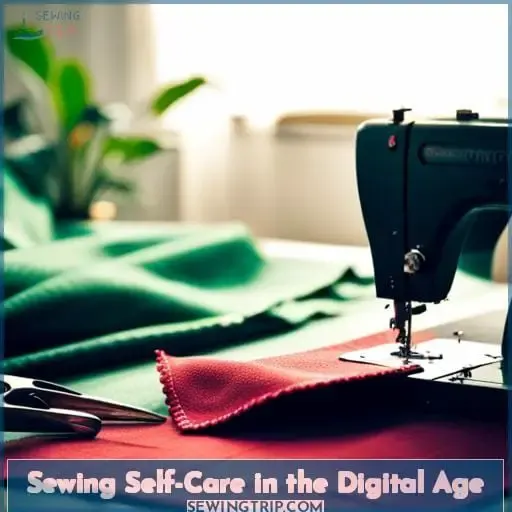This site is supported by our readers. We may earn a commission, at no cost to you, if you purchase through links.
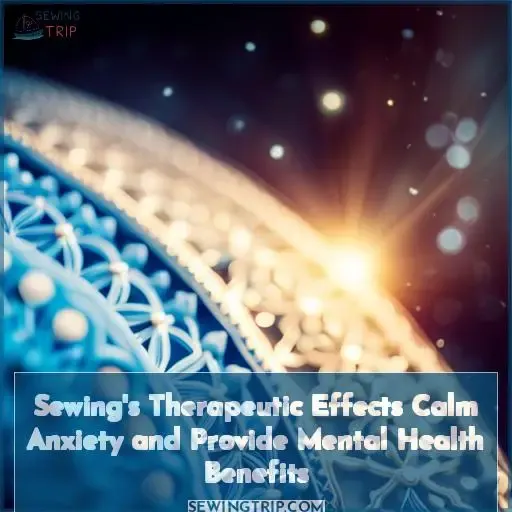
Sewing soothes the soul as each prick and pull of needle and thread unknots anxiety.
Lose yourself in colorful fabrics, patterns that challenge yet comfort through repetition.
Feel fears fade with every snip, worries unwinding as bobbin embraces thread.
Create beauty birthed from turbulence within, hands steadying, heart easing.
Let sewing’s rhythm resonate, cares reduced with each stitch savored.
Immerse in mindful making, tension transforming to tranquility.
Table Of Contents
- Key Takeaways
- Sewing Promotes Relaxation and Stress Relief
- Sewing Builds Self-Confidence and Self-Esteem
- Sewing Encourages Personal Expression
- Sewing Fosters Community and Social Connection
- Sewing Provides Therapeutic Benefits
- Sewing Benefits Those With Mental Health Issues
- Sewing Self-Care in the Digital Age
- Frequently Asked Questions (FAQs)
- Conclusion
Key Takeaways
- Sewing promotes mindfulness and reduces stress by requiring focused concentration on the repetitive motions of stitching.
- Completing sewing projects boosts self-esteem and gives a sense of accomplishment that counters anxiety.
- Sewing allows for self-expression that channels worries into tangible creations.
- Sewing circles provide community connections that alleviate isolation which can heighten anxiety.
Sewing Promotes Relaxation and Stress Relief
As you grasp the fabric and guide it carefully through the machine, your mind quiets, fully focused on the task at hand.
The repetitive motion and concentration needed for sewing keeps worries and anxious thoughts at bay.
This mindful, present-moment awareness while sewing can provide deep relaxation and relief from stress.
Mindfulness While Sewing
When you’re sewing, you’re fully engaged in the present moment, which promotes mindfulness and reduces stress.
- Focusing intently on each stitch keeps your mind anchored in the here and now.
- Paying close attention to your technique and precision takes you into a state of flow.
- The rhythmic motion of sewing can induce a meditative calm.
- Immersing yourself in sewing helps quiet your mind and relieve anxiety.
Distraction From Negative Thoughts
Engrossing your attention in mindful stitching, you’re redirecting thoughts away from harmful ruminations.
As you concentrate on crafting calm through thoughtful threadwork, sewing provides a positive distraction from anxiety.
This mindful, creative thinking helps interrupt cycles of negative thoughts, bringing liberation.
Immersing yourself in free sewing helps quiet your inner critic, enhancing understanding.
Overall, sewing can be an effective coping strategy, easing anxiety by focusing your mind on the positives.
Sewing Builds Self-Confidence and Self-Esteem
As you learn sewing skills and techniques, you gain confidence in your abilities with each project you complete.
Setting realistic sewing goals and achieving them, no matter how small, boosts your self-esteem.
Continued practice helps you expand your skills, taking on more advanced projects that previously seemed out of reach.
Developing New Skills
You’ll sharpen your concentration and fine motor skills as you learn sewing techniques, boosting self-confidence each time you master a new stitch or pattern.
As you grow your sewing skills, you flex cognitive abilities, enhancing mental acuity.
The challenges of interpreting instructions, maneuvering fabric, selecting materials awaken your ingenuity.
Each sewing milestone affirms your capability to set goals, problem-solve patiently, and manifest creations, nurturing emotional resilience.
Sewing brings personal fulfillment.
Achieving Goals
You complete sewing projects and attain a sense of accomplishment.
Setting incremental goals and meeting them builds confidence.
Learning new techniques expands your skills.
Solving problems that arise cultivates resilience.
Finishing an item gives a sense of capability and pride.
Sharing your creations connects you with community.
Sewing Encourages Personal Expression
Now that you have gained self-confidence and improved your self-esteem through sewing, let’s explore how this craft encourages personal expression.
Sewing isn’t just about creating functional items; it allows you to unleash your creativity and express yourself in unique ways.
Through the art of stitching, you can create pieces that reflect your individual style and personality.
Sewing provides a canvas for artistic expression where fabric becomes an extension of yourself.
Whether it’s choosing vibrant colors, intricate patterns, or adding embellishments like embroidery or beading, each stitch tells a story about who you are.
This process fosters emotional wellness by allowing you to channel your feelings into something tangible.
Engaging in mindful crafting through sewing helps reduce anxiety levels as it requires focus on the present moment.
The rhythmic motion of needle and thread brings calmness to the mind while allowing thoughts to flow freely without judgment.
Incorporating sewing into your life not only enhances mental health but also promotes brain growth by stimulating cognitive functions associated with creativity and problem-solving skills.
Sewing Fosters Community and Social Connection
The communal nature of sewing enables connecting with others who share similar interests or experiences.
Participating in collective sewing projects or social sewing circles provides opportunities for camaraderie through shared concentration on creative endeavors.
These collaborative spaces facilitate skill-sharing and allow individuals to contribute to larger tapestries conveying community stories.
For those seeking connections, sewing circles can provide a retreat from isolation to bond over craft.
Sewing becomes a vehicle for collective creativity, with each contribution vital to the whole.
Whether participating in community art initiatives or informally gathering to stitch, the tactile connections of sewing help strengthen social bonds.
Through sewing, people find both personal self-expression and interpersonal understanding.
Sewing Provides Therapeutic Benefits
As a sewing therapist, I often recommend needlework to help individuals cope with difficult experiences.
The repetitive motions involved in sewing can have a calming, meditative effect that provides mental space to process emotions, trauma, or grief.
Creating something tangible through sewing also gives a sense of control and accomplishment that’s therapeutic during times of upheaval or loss.
Processing Emotions
Through self-expression and communal bonds alike, you’re processing emotions.
You translate inner turmoils into stitched patterns or find solace in sharing struggles with empathetic ears.
As you mindfully stitch, each motion aids emotional healing.
The repetitive gestures soothe frayed nerves.
Creative expression blossoms anew with every curve of thread, granting insight into subconscious storms.
Therapeutic crafting thus mends mental health.
Anxiety unwinds with each pull of the needle.
Turmoil transforms into tangible creation.
Stress lifts as motor skills strengthen.
Hands steady alongside calmed thoughts.
Brains grow anew through mindful motion.
Trauma and Grief Therapy
While sewing won’t resolve deep trauma or erase grief, you’ll find the repetitive motions and quiet concentration can help you process painful emotions and experiences as you create something tangible.
Expressive Stitches and Healing Threads allow Creative Recovery through Threaded Resilience, Stitching Through sorrow while managing anxiety.
Sewing’s therapeutic effects provide mental health benefits, whether for trauma therapy, grief therapy, or simply coping day-to-day.
Sewing Benefits Those With Mental Health Issues
As a craft therapist, I often recommend sewing and textile work to my clients struggling with anxiety or depression.
The repetitive motions and focused attention needed for sewing help calm the mind, while also providing a creative outlet to express emotions.
Sewing activities may also aid those with dementia by triggering memories and facilitating social connections.
Anxiety and Depression
You’d cope with everyday anxiety and depression by sewing’s calming and stress-relieving therapeutic effects.
Mindful stitching and creative threads foster emotional wellness and self-discovery, easing stress with seamless confidence boosts.
Therapeutic stitches and mindful healing amid sewing circles build social connection, helping you manage anxiety and depression through liberating creative expression.
Dementia
Certain sewing activities can help some dementia patients.
Triggering memories and enabling conversations.
Simple tasks like threading a needle or sorting buttons may stimulate recollection of past skills.
The creative process also encourages social engagement.
As patients work alongside caregivers, sewing quilts or embroidery.
These purposeful activities promote emotional expression, cognitive wellness, and meaningful connections.
Sewing Self-Care in the Digital Age
You can use sewing as a self-care tool to stay grounded in the digital age.
Connect with online sewing communities.
Find mindful crafting videos and tutorials.
Get support from virtual sewing circles.
Attend digital sewing workshops.
Sewing provides social connection and mental health benefits to counteract sensory overload from technology.
By engaging in mindful sewing activities, you can find relief from anxiety.
Participate in digital sewing communities for self-care through:
- Sharing your creations
- Supporting others’ projects
- Learning new techniques
- Making social bonds – despite physical distance
Sewing’s therapeutic effects foster mental wellness in the digital world.
Frequently Asked Questions (FAQs)
What are some beginner-friendly sewing projects for someone just starting out?
- Start with hand sewing by making simple items like sewn felt ornaments or fabric coasters.
- Learn to sew on a button and repair a seam.
- Try tracing a pattern and sewing a simple tote bag or pincushion.
Focus on the process, be patient with yourself as you acquire this enjoyable new skill.
How can I make sewing a more affordable hobby? What are some ways to get supplies without spending a lot of money?
Check thrift stores for fabric scraps to practice on.
Swap materials with crafty friends.
Utilize public libraries and their crafting offerings.
Scout yard sales and estate sales for cheap or free sewing machines and tools.
Join crafting sites to find free project patterns and tutorials.
I don’t have anyone to sew with. Are there any online communities where I can connect with other sewing enthusiasts?
Absolutely!
Seek online sewing groups to connect with kindred spirits.
Share struggles and triumphs on this creative journey with compassionate peers.
Their wisdom lifts burdens; stitching together understanding and belonging.
I get frustrated easily if things don’t turn out perfectly. Do you have any tips for managing expectations and not getting down on myself while learning to sew?
Stay focused on the process, not the outcome.
Celebrate small successes.
Don’t compare yourself to others.
Progress takes patience and practice.
Allow yourself to make mistakes as part of learning.
I have limited mobility in my hands. Are there any adaptive devices or techniques you’d recommend so I can still enjoy sewing?
Focus on adaptive devices to enable sewing.
Contact an occupational therapist to evaluate your needs.
Ergonomic aids like specialized grippers or touchpads can compensate for limited mobility.
Purposefully pacing yourself prevents frustration.
Seek community and connection through adaptive sewing groups.
Conclusion
As you immerse yourself in sewing’s soothing rhythm, you’ll find your anxieties literally falling away stitch by stitch.
The therapeutic power of mindful making dissolves distress, building confidence and community for unparalleled mental health.
Let sewing mend your uneasy soul, embracing self-expression and creativity as the ultimate care.
Each prick of the needle eases pains within, proving conclusively that sewing settles anxious minds.

